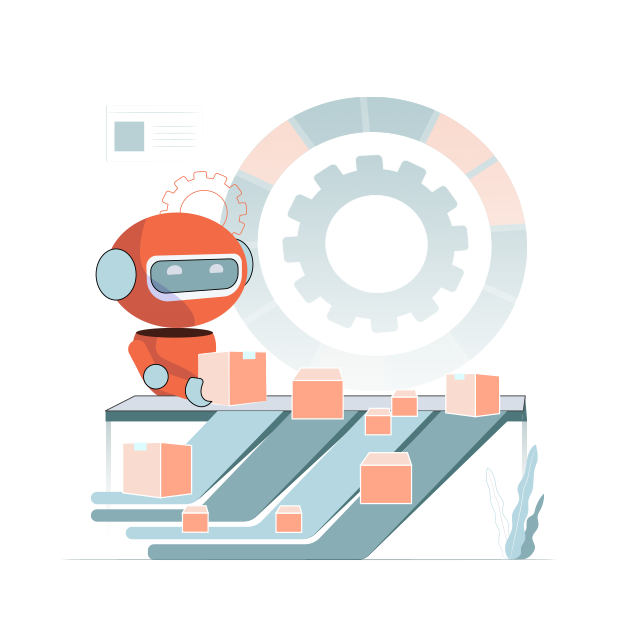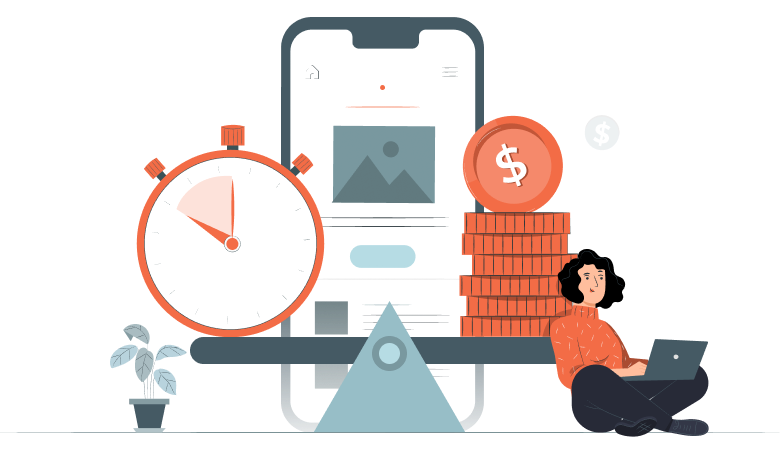Determining the ideal machine learning framework for your organization is a challenging task, and determining the right fit for your product is much more difficult. Global machine learning as a service market size is expected to reach around 305.62 billion dollars by 2030.
Let’s learn about the top frameworks that are contributing to the growth of ML.
What are machine learning frameworks?
A machine learning framework is a library, user interface, or other tools that make it easier to develop machine learning models. It helps software developers, data scientists, and machine learning engineers to quickly create machine learning models.
It learns from the data you provide and generates a predictive answer without being trained. Using ML frameworks, developers can quickly and easily design, train, and deploy machine learning models without writing any complex code.
This machine-learning technology enables machines to learn and adapt from examples and experience without being directly programmed. Machine learning makes your programmes smarter by allowing them to learn from the data you give automatically.
Top machine learning frameworks
1. Amazon Machine learning
Amazon Machine Learning is a cloud-based platform and service that allows developers to create ML algorithms.
Developers can use this framework to generate ML models using a variety of visualization tools without having to understand complex ML methods and technologies.
Predictive ML models can be created by developers by running binary classification, multiclass categorization, or regression on data that is stored in RDS, Redshift, or Amazon S3.
When the models are developed, Amazon ML uses simple APIs to generate predictions for the application. No customized prediction-generating code or infrastructure maintenance is required because Amazon ML serves everything.
With Amazon ML, you can make batch and real-time predictions, evaluate the quality of machine learning models and make predictions based on the patterns in the input data by utilizing ML models.
2. TensorFlow
Google’s TensorFlow is an open-source software framework that enables data pre-processing, designing features, and serving models.
It has a wide range of tools and community resources that enable it to train and deploy both ML and deep learning models. It can be used in a variety of programming languages like Python, JavaScript, C++, and Java.
With the help of the data flow graphs that TensorFlow supports, a set of algorithms can be used to process batches of data or tensors.
Engineers and deep neural scientists can construct deep learning algorithms and models with the use of a library of pre-trained models.
TensorFlow integrates machine learning and deep learning models and puts them over a big dataset to train these models to reason and provide logical results on their own.
3. Shogun
Shogun is a C++-based open-source machine learning framework that includes a broad selection of ML algorithms and data structures.
This is designed for integrated, massive learning across a variety of feature types and learning situations, such as exploratory data analysis, regression, or classification.
It guarantees that the underlying algorithms are clear and accessible, which is not restricted to C++. It also works with Python, C#, Java, Lua, R, Octave, Matlab, Ruby, and other languages.
Developers can use this framework to handle large amounts of data for machine learning applications.
Shogun is excellent for creating algorithms and data structures, particularly in the academic and scientific fields.
It can also communicate with other machine learning libraries, such as LibLinear, LibSVM, SVMLight, and LibOCAS.
4. PyTorch
Python, C++, and CUDA are used to create the open-source cloud-based machine learning framework PyTorch. This framework created by Facebook includes a variety of features such as libraries, tools, and distributed training.
PyTorch uses both CPUs and GPUs to do regression, classification, neural networks, and other tasks. It is compatible with libraries like Numba and Cython and was made to integrate with Python.
Due to its ability to implement parallel programs over several GPUs, PyTorch offers great GPU support. It also has a more user-friendly UI. It also supports Lua for UI development and makes data sharing with other libraries easier.
It is useful for constructing computational graphs and has a hybrid front-end development for flexible use.
5. Apache SINGA
An open-source machine learning framework, Apache SINGA has a scalable design and can function on a variety of hardware. It is a large distributed deep learning framework that trains huge deep learning models on large datasets and allows users to customize the models.
It is easy to use, making the distributed training process accessible to users. It supports recurrent neural networks (RNN), convolutional neural networks (CNN), and limited Boltzmann machines and was created using a simple programming method based on layer abstraction.
It is one of the best ML frameworks for large-scale learning operations, and it has applications in a variety of industries, including banking, software development, real estate, and healthcare.
6. Scikit-Learn
Scikit-Learn is a free and open-source Python machine learning framework developed in C, C++, Python, and Cython.
It is the best framework for data mining and analysis and is used for computations including both supervised and unsupervised learning.
By using libraries like SciPy, NumPy, and Matplotlib, it can carry out both numerical and scientific operations.
It is able to execute a number of ML tasks, including stochastic gradient descent models, support vector machines (SVMs), K-nearest neighbor, linear regression, and random forest regression.
Scikit-Learn simplifies the procedure of tweaking and debugging models and allows the developers to change the algorithm’s specified parameters while in use or during runtime.
7. Keras
Keras is a popular open-source Python interface for machine learning and deep neural networks based on TensorFlow.
It features a variety of pre-trained models as well as a high-level API that allows multi-platform and multi-backend integrations.
Keras is now used by big IT businesses such as Uber and Netflix to boost scalability.
The same code can be used to execute this neural network library on both the CPU and GPU. This framework works with PlaidML, Theano, R, and Microsoft Cognitive Toolkit.
With the help of Keras, developers may maximize the scalability and cross-platform capabilities of the apps they create.
ML developers use it for quick prototyping and can implement it in a variety of fields such as healthcare, business insights, sales projections, customer assistance, virtual assistants, and so on.
8. Theano
Theano is a fast ML library that works well with NumPy for data processing. It is created in Python and CUDA and distributed under the BSD license.
Theano effectively performs symbolic differentiation using GPUs. It works well with multidimensional arrays and enables users to optimize mathematical operations, most often in deep learning using effective machine learning algorithms.
Theano can reach speeds comparable to those of hand-crafted C solutions when facing challenges involving a considerable amount of data. Theano has a wide range of applications in finance and logistics projects.
It can handle exponential and log functions while performing data-intensive computations on CPU and GPU architectures, while automatically avoiding bugs and errors. Additionally, it includes tools for unit testing and validation.
9. Caffe
Another ML and DL system created in C++ is Caffe, also known as Convolutional Architecture for Fast Feature Embedding.
It is designed with articulation, speed, and verified quality as top concerns. The BSD 2-Clause license makes it available to users.
With the BSD-approved C++ library and Python interface, users can switch between the graphics processing unit (GPU) and the central processing unit (CPU), model, and optimize with less coding requirement.
NVIDIA, cuDNN, and IntelMLK are just a few examples of the computational kernel libraries that Caffe supports for GPU- and CPU-based acceleration. It is created by network contributors and the Berkeley Vision and Learning Center (BVLC).
Caffe’s quick processing time makes it perfect for extensive commercial use as well as research experiments.
Caffe excels in applications involving speech recognition, multimedia, and computer vision.
10. H2O
H2O is another open-source ML framework and AI tool that uses predictive analytics and mathematics to make data- and insight-driven decisions.
Java is the primary programming language used in H2O, and the REST API enables external programs and scripts to access H2O’s functionality.
It is generally used for predictive modeling, risk and fraud analysis, insurance analytics, ad technology, health services, and consumer intelligence.
In order to train machines based on data insights, it incorporates database-agnostic compatibility with open-source Breed technology.
In addition to Python, R, Java, JSON, Scala, JavaScript, and a web interface, H2O also contains a number of models.
The most recent iteration of H2O is H2O-3, an in-memory platform that works with a variety of interfaces, including Flow’s notebook/web interface, Java, JSON, R, Python, and Scala.
It also combines easily with large data technologies like Spark and Hadoop.
Many well-known algorithms, including GBM, Random Forest, Deep Neural Networks, Word2Vec, and Stacked Ensembles, are implemented by H2O-3.
Developers can add custom algorithms and data transformations to H2O-3 while having access to all client systems because of its high flexibility and extensibility.
Advantages and disadvantages of machine learning frameworks

Conclusion
A machine learning framework is preferred and chosen based on the particular algorithms it will use as well as other needs. ML frameworks are significantly streamlining the activities and producing effective outcomes from the supplied dataset.
Organizations and enterprises are expanding quickly and adjusting to technology as a result of the increased usage of machine learning. The predicted and automated findings are extremely beneficial to businesses. Machine learning frameworks are highly in demand and now enterprises are quick in adapting to it as well as developing in-house tools.
How can NeoITO help with ML?
Our team of experts works to provide highly effective, functional machine learning products and solutions for businesses. Contact NeoITO if you are looking to develop customized ML services; we can assist you to develop ML-driven solutions to transform your business.
FAQ
Is TensorFlow an ML framework?
TensorFlow is an open-source software framework created by Google. It’s a Python library that uses C++ to build and run dataflow graphs. Many classification and regression methods, as well as deep learning and neural networks, are supported. It comprises a diverse set of tools and community resources to train and deploy ML and deep learning models.
Which one is better? PyTorch or TensorFlow?
Tensorflow is better for the production and deployment due to its tools like tensorflow serve. Better visualization is possible with TensorFlow, whereas PyTorch has better GPU comparability and flexibility. TensorFlow outperforms PyTorch when it comes to putting learned models into use.
What ML framework does Apple use?
Apple uses Core ML, which serves as the foundation for domain-specific frameworks and capabilities. Core ML offers sound analysis for recognizing sounds in audio, speech for translating audio to text, natural language processing for handling text, and vision for analyzing pictures. Core ML-generated models are capable of carrying out a wide range of tasks that would be challenging or impractical to do in code.
What ML framework does Google use?
TensorFlow is an open-source machine learning framework developed by Google. Many internal Google teams and products, including Search, Gmail, Translate, Maps, Android, Photos, Speech, YouTube, and Play, use TensorFlow.




